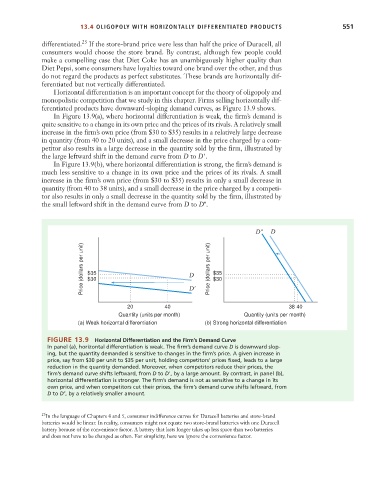Page 577 - Microeconomics, Fourth Edition
P. 577
c13marketstructureandcompetition.qxd 7/30/10 10:44 AM Page 551
13.4 OLIGOPOLY WITH HORIZONTALLY DIFFERENTIATED PRODUCTS 551
differentiated. 25 If the store-brand price were less than half the price of Duracell, all
consumers would choose the store brand. By contrast, although few people could
make a compelling case that Diet Coke has an unambiguously higher quality than
Diet Pepsi, some consumers have loyalties toward one brand over the other, and thus
do not regard the products as perfect substitutes. These brands are horizontally dif-
ferentiated but not vertically differentiated.
Horizontal differentiation is an important concept for the theory of oligopoly and
monopolistic competition that we study in this chapter. Firms selling horizontally dif-
ferentiated products have downward-sloping demand curves, as Figure 13.9 shows.
In Figure 13.9(a), where horizontal differentiation is weak, the firm’s demand is
quite sensitive to a change in its own price and the prices of its rivals. A relatively small
increase in the firm’s own price (from $30 to $35) results in a relatively large decrease
in quantity (from 40 to 20 units), and a small decrease in the price charged by a com-
petitor also results in a large decrease in the quantity sold by the firm, illustrated by
the large leftward shift in the demand curve from D to D .
In Figure 13.9(b), where horizontal differentiation is strong, the firm’s demand is
much less sensitive to a change in its own price and the prices of its rivals. A small
increase in the firm’s own price (from $30 to $35) results in only a small decrease in
quantity (from 40 to 38 units), and a small decrease in the price charged by a competi-
tor also results in only a small decrease in the quantity sold by the firm, illustrated by
the small leftward shift in the demand curve from D to D .
D" D
Price (dollars per unit) $35 D Price (dollars per unit) $35
$30
$30
D'
20 40 38 40
Quantity (units per month) Quantity (units per month)
(a) Weak horizontal differentiation (b) Strong horizontal differentiation
FIGURE 13.9 Horizontal Differentiation and the Firm’s Demand Curve
In panel (a), horizontal differentiation is weak. The firm’s demand curve D is downward slop-
ing, but the quantity demanded is sensitive to changes in the firm’s price. A given increase in
price, say from $30 per unit to $35 per unit, holding competitors’ prices fixed, leads to a large
reduction in the quantity demanded. Moreover, when competitors reduce their prices, the
firm’s demand curve shifts leftward, from D to D , by a large amount. By contrast, in panel (b),
horizontal differentiation is stronger. The firm’s demand is not as sensitive to a change in its
own price, and when competitors cut their prices, the firm’s demand curve shifts leftward, from
D to D , by a relatively smaller amount.
25 In the language of Chapters 4 and 5, consumer indifference curves for Duracell batteries and store-brand
batteries would be linear. In reality, consumers might not equate two store-brand batteries with one Duracell
battery because of the convenience factor. A battery that lasts longer takes up less space than two batteries
and does not have to be changed as often. For simplicity, here we ignore the convenience factor.

